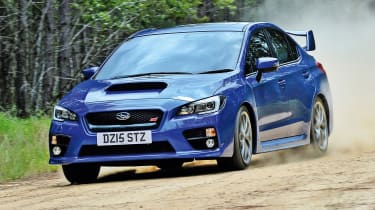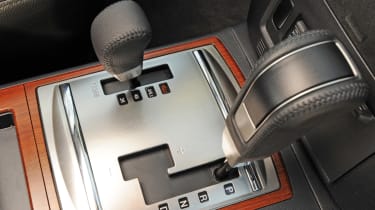Four-wheel drive is most commonly associated with rugged off-road SUVs, but it is also found in a number of other types of car. To make matters more complex, not only does four-wheel drive appear on a number of different types of car, but the system itself comes in a number of different forms, too. Certain four-wheel-drive configurations are more common than others, and each one works to give you as much grip as possible, but in different ways.
Four-wheel drive-transmissions can vary from the purely mechanical to being almost entirely electronically controlled. There are even some trick traction control systems in use, such as Citroen and Peugeot’s GripControl system, which mimics the effect of 4×4 without actually sending power to all four wheels.
Audi’s quattro system is part of almost every car in the brand’s range, while performance cars such as the BMW M5 and the Toyota GR Yaris prove that four-wheel drive isn’t just for greenlaning or driving out in the wilderness – it can help you get the maximum from your car’s performance, too.
Our 4×4 guide will talk you through the various systems available to you and what makes them different, plus the advantages and disadvantages of each one.
For our in-depth explainer into the different four-wheel-drive systems, read on…
Selectable four-wheel drive
If you’re serious about heading off the beaten track, then a selectable four-wheel-drive system will be best.
This is, in essence, the same system that made its debut on the original Willys Jeep and first Land Rovers, it features a dual-range gearbox that delivers ultra-low gearing for steep inclines and descents. Today, an updated version of this system is favoured by rugged pick-ups at one end of the market and luxury off-roaders such as the Range Rover at the other.
With its bulky transfer case and chunky components, this heavyweight system favours ultimate traction and toughness rather than efficiency. Most of the pick-ups have an option to run in rear-wheel-drive only in an effort to boost fuel returns on the road, but the gains at the pump are minimal.
Many older cars rely on a small lever to manually select 4WD and the low and high ratios, but most new models now get a small rotary controller or dashboard buttons that allow electronic switching between the drive modes.
In low-range four-wheel-drive mode, these models are hugely capable in the rough stuff. This is partly down to the gearing, but also the use of locking differentials, which fix the torque split between the front and rear axles at 50:50. Some models also have this function for the rear wheels, while some models, such as the Mercedes G-Class, also allow you to lock the front differential, for the ultimate in traction.
Perhaps one of the most advanced versions of this system is found on the Range Rover, which combines the old-school transmission components with a Terrain Response control system. It uses similar hardware to rival models, but employs a clever traction control that helps eliminate wheelspin. It can assess the condition of the ground automatically, or drivers can manually select from Sand, Snow, Mud, Rock and Gravel settings. There’s also All-Terrain Progress Control, which is, in effect, low-speed, off-road cruise control.
On-Demand four-wheel drive
Four-wheel drive really started to gain traction with buyers in the eighties, and as a result manufacturers started to invest more heavily in the technology. The result of this was the introduction of ‘on demand’ systems, which promised the safety and grip benefits of all-wheel drive, but with the efficiency and usability of regular two-wheel drive.
This type of system proved to be particularly well suited to existing front-wheel-drive models that had transverse engines. Cars such as the Vauxhall Cavalier Mk3 led the way, featuring transmissions that delivered over 90 per cent of the engine’s torque to the front wheels during normal driving and had the ability to automatically disengage the rear axle during braking for greater stability.
It was the introduction of the electronically controlled Haldex centre differential in 1998 that allowed brands to relatively easily add all-wheel-drive cars to their line-up. This allowed the car to run in two-wheel drive under normal conditions, which helped save fuel. Yet these early systems were reactive and waited for the front wheel to spin before sending torque to the rear axle. In very slippery conditions this led to scrappy handling as individual wheels were flooded with power as the transmission frantically tried to find grip.
But constant development, more powerful electronics and faster-acting differentials have meant that this type of system now comes close to matching more traditional all-wheel drive for traction. In fact, even Land Rover has taken to using this type of ‘on demand’ set-up for its Discovery Sport and Evoque. In combination with traction control and Terrain Response it allows these cars to perform almost as well off-road as the full-sized Range Rover.
Nissan and Renault also use similar systems, even letting drivers choose between two and four-wheel-drive modes, just like the old-school selectable set-ups.
Permanent four-wheel drive
When four-wheel drive left the farmyard and hit the road, it was a fairly simple permanent set-up that was used. Cars such as the sixties Jensen FF and eighties Audi Quattro made these systems famous, and it wasn’t long before mainstream brands such as Ford had an affordable 4×4 saloon in their range.
Advances in transmission tech mean these systems are getting rare, but brands such as Audi and Subaru have kept the faith. As its name suggests, this system is permanently engaged so that all four wheels are always being driven. It’s not as fuel-efficient as ‘on demand’ set-ups, but the upshot is even greater traction in slippery conditions. This is because the transmission doesn’t have to react to surface changes, so there isn’t the odd spike of power being sent to individual wheels as the sensors try and limit wheelspin.

Audi was one of the pioneers of this, and most cars from the A3 above get a redeveloped version of it. Originally using a Torsen centre differential and later Audi’s own set-up, it features a permanent torque split of either 50:50 or 40:60. But the centre diff also has the capability of shuffling up to 100 per cent of the power to an individual wheel or axle in extreme circumstances.
Subaru takes matters to the next level with its Symmetrical 4WD set-up. By mounting the longitudinally oriented engine, propshaft and rear differential in a straight line, engineers can incorporate equal-length driveshafts front and rear. Factor in Subaru’s low-line boxer engines and you should get balanced, predictable handling, together with even power distribution for enhanced traction. Like the Audi set-up, a viscous centre coupling or an electronically controlled unit can vary power front to rear depending on the conditions.
Advanced Traction Control
While 4WD brings many benefits, for some buyers the extra weight and complexity isn’t a price worth paying. But Citroen, Fiat and Peugeot have an alternative in their clever traction-control systems.
The French firms’ Grip Control set-up features five driving modes, which can be accessed using a rotary controller. Fiat’s system is simpler, with drivers simply prodding a single button when grip levels fall away. If all you’re tackling is a snowy drive, these set-ups are effective. But bear in mind 80 per cent of the traction boost comes from the standard mud and snow tyres.

